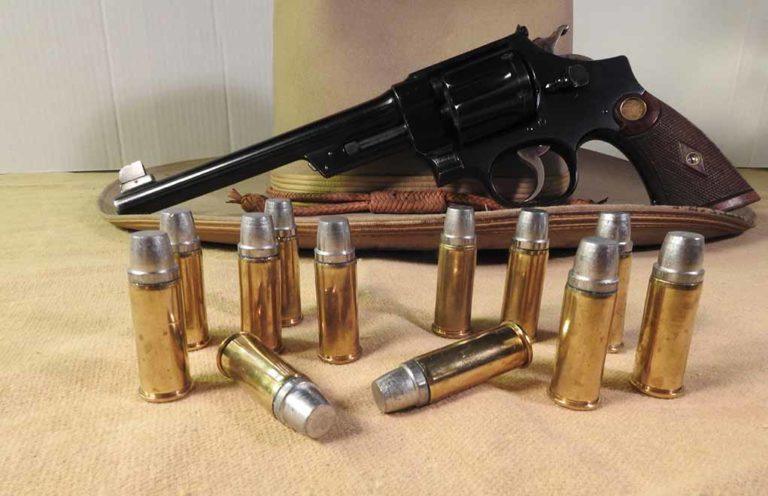
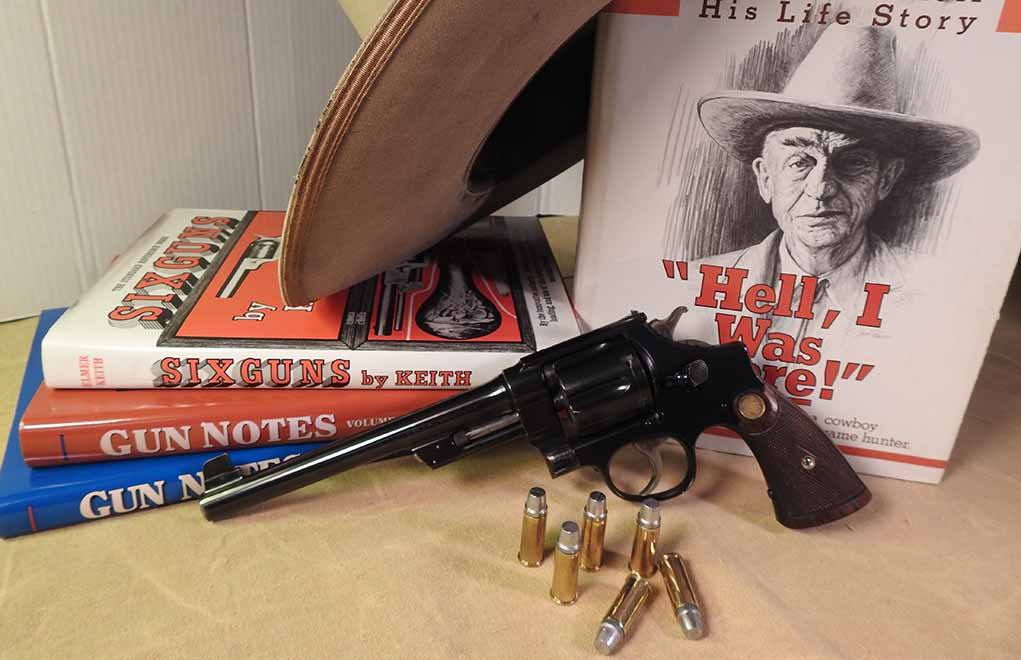
Elmer Keith proved that with practice and know-how, long-range shots with a revolver are possible.
What's Special About Smith & Wesson Triple-Lock:
- Built on S&W's N-frame.
- Cylinder has three locking points making it fit for larger and more powerful cartridges.
- Original Triple-Lock did not have special heat-treated cylinders.
- Available with barrels from 3.5 to 8.5 inches.
- At first, there were two major models, one with fix sights and the Target Model with adjustable sights.
Item No. 17 on the auction list reads, “.44 Hand Ejector First Model (Triple-Lock) serial number 4325, .44 S&W Special, 7.5-inch barrel, blue finish, shipped April 7, 1910, Honeyman Hardware Co., Portland, OR.”
This is interesting in its own right for wheelgun aficionados, but it’s even more so when you ponder the revolver’s journey from Oregon and its intervening experiences in those 100-plus years between 1910 and 2016, at which time it landed in the hands of a Nebraska firearms collector.

Although much of the Smith & Wesson revolver’s early history is unrecorded; and it might have remained unnoted, perhaps being passed anonymously from generation to generation, owner to owner—had it not landed in the hands of one of the foremost pistoleers of the 20th century: Elmer Keith.
About Elmer Keith
I know you know about Elmer Keith. But humor me while I briefly describe his influence as one of the top gun writers of his day, which is to say a good portion of the mid-1900s. To give you an idea of the Elmer Keith era, he published his first firearms book, Sixgun Cartridges and Loads, in 1936, and his last, Hell, I Was There in 1979.
Keith was a rancher in Idaho, as well as a hunter and firearms enthusiast. He is perhaps most often associated with handguns and handgun hunting, but he was also an expert with the rifle and shotgun and made significant contributions to all three of those disciplines.
A man of small physical stature but a large personality and reputation, Keith favored a large Stetson cowboy hat and cigar; sometimes, a pipe. In addition to books, Keith wrote popular firearms columns and articles for American Rifleman and Guns and Ammo magazines, as well as other magazines (for one, True magazine). He’s best known, in my mind anyway, for his affiliation with Guns and Ammo, even though I have some 1950s-era editions of American Rifleman listing Keith on the masthead. This included the March 1950 edition, in which Keith was introduced as a staff writer—or as they put it, “Keith Joins Rifleman Staff: The noted Western gun writer augments Dope Bag panel of experts.”
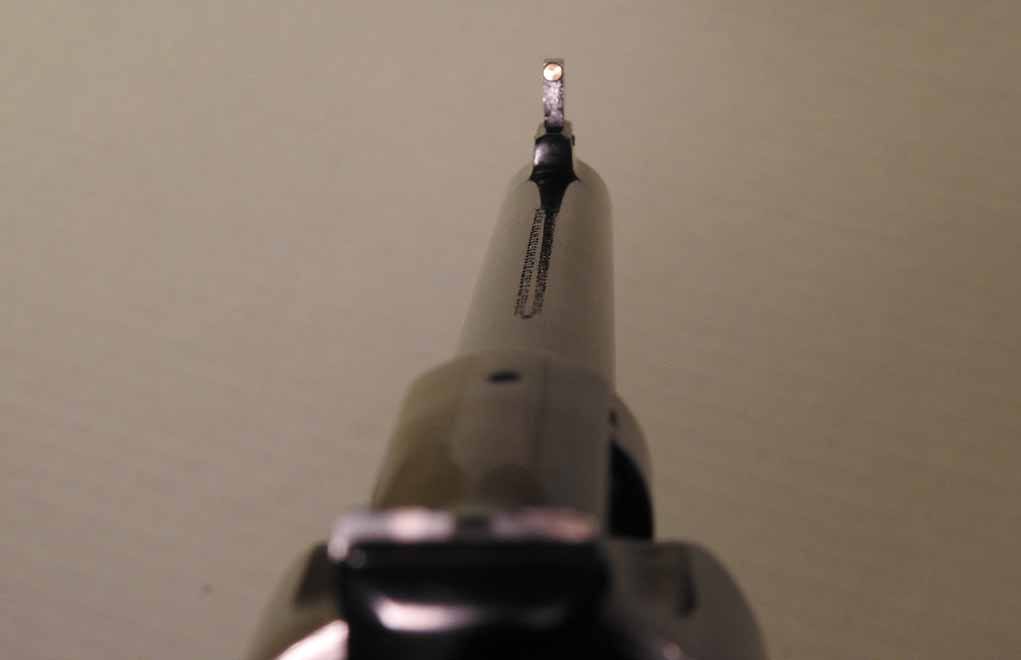
Keith was known for his fondness of big-bore firearms, particularly handguns—even more particularly, revolvers. A serious hunter who believed in using enough gun for the job at hand, Keith was not content with the handgun cartridges of his day. Large, slow bullets were not for him, nor were light, fast bullets. He wanted large, fast bullets, and he experimented with available cartridges, pushing the limits of cartridges and firearms alike.
Hefty, Hefty, Hefty
The beefy Triple-Lock, also known as the New Century (it was introduced in 1907), was right up his alley.
More Gun Collecting Info:
- The Walther PP Series
- The Quintessential 22 Pistol: The Colt Woodsman
- The Rocky History Of The L.C. Smith
- The Browning SA-22
- Colt Python: The Cadillac Of Revolvers
In designing the Triple-Lock, Smith & Wesson set out to create a large-frame wheelgun that could fire more-powerful loads. Based on earlier swing-out cylinder double-actions, such as the .32 Hand Ejector, .38 Military and Police and .38 S&W Special, the new revolver was beefed up, especially in the frame, to handle the company’s newly designed .44 Special cartridge, which was based on lengthening the .44 Russian case to provide additional space for powder. The result is often considered one of the finest revolvers ever made.
The “Triple-Lock” aspect of its name came from a design that incorporated three locking mechanisms—one at the forward end of the ejector rod, one locking into the face of the cylinder and the third in between a notched lug and bolt forward of the cylinder but at the rear of the ejector shroud. The three mechanisms provided solid lockup and a strong foundation capable of handling more-powerful loads, such as the .44 S&W Special.
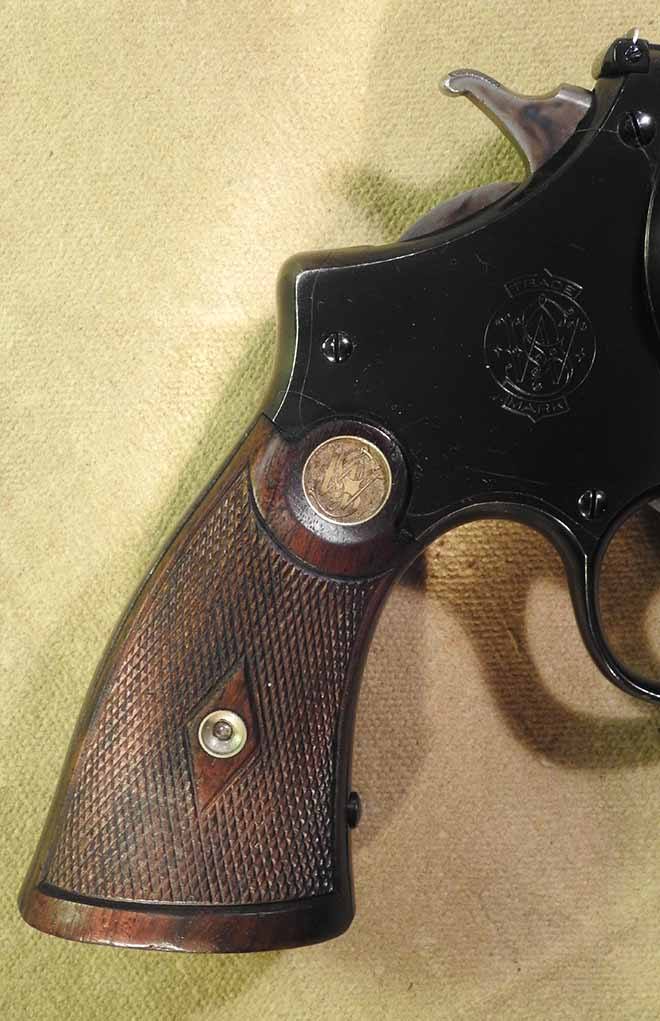
And that gets us back to Elmer Keith. He is acknowledged for his work in heating up handloads for the .38 Special, .41 Long Colt and .44 Special—and pushing firearms and ammunition manufacturers to follow suit. This resulted in the development of Magnum cartridges we know today: the .357, .41 and .44 Magnums.
If you play firearms word association with a handgun aficionado and say, “Elmer Keith,” the response will likely be “.44 Magnum.” (We’ll save for another discussion Keith’s work with wildcat rifle cartridges that was instrumental in developing other cartridges. .338 Winchester Magnum, anyone?)
King of the Six-Gun Cartridges
But back to the .44 Special. Keith reportedly proclaimed the .44 Special “king of the six-gun cartridges,” but he continued to push it, using it as a basis for reloading and range experiments to push velocities of heavy bullets. He is known to have used triple-locks (as well as Colt single- actions) in his work with the 44 Special.
As the reliable reference book, Cartridges of the World, points out, as an accurate and powerful big-bore revolver cartridge, the .44 Special was never factory loaded to its full potential. “It was left to the handloader to develop truly effective hunting loads … Experiments to maximize the .44 Special’s big-game hunting potential by men like Elmer Keith culminated in the .44 Magnum.”
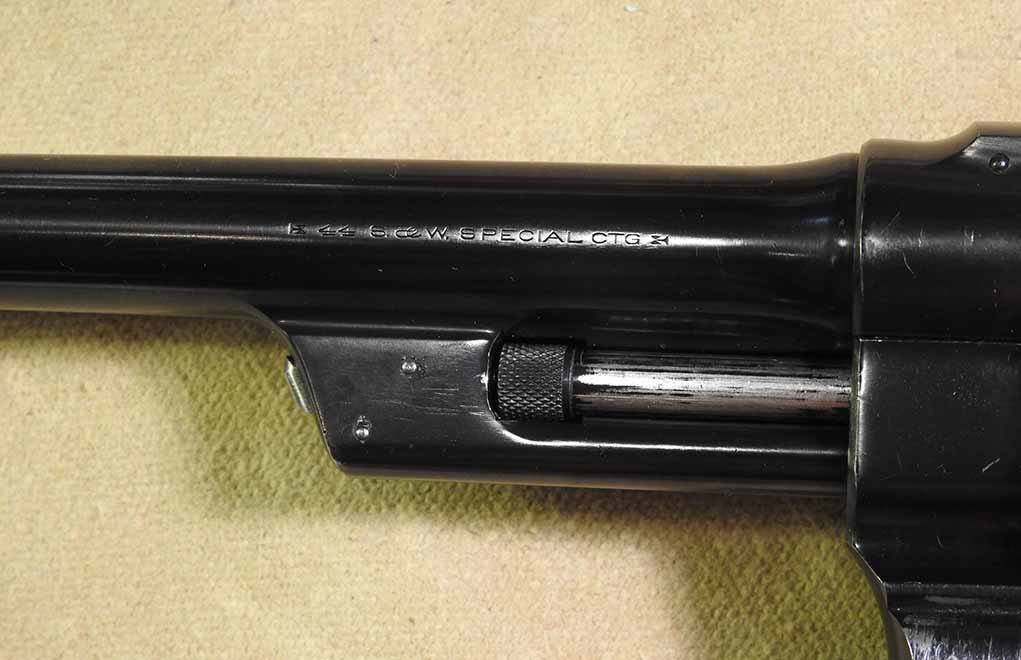
But we were talking about this particular Smith & Wesson .44 Special—the one purchased from the Keith collection after his death in 1984.
A Shooter, Not A Collector
Ben Heskett, owner of Serial No. 4325, can attest to Keith’s penchant for overpowered, if not overpowering, loads.
“It obviously saw a lot of heavy loads and a lot of shooting, because it was noticeably out of time,” Heskett said. “And that’s kind of the curse with Elmer’s hot-rod .44 Special loads.”
Heskett sent it to a gunsmith, Alex Hamilton of Ten-Ring Precision in San Antonio. “[He’s] one of the few remaining Smith & Wesson revolver meisters left,” Heskett said. “He re-timed it and went all through it.” However, otherwise, he left it intact.
Heskett doesn’t just set the revolver on a shelf to admire; he shoots it.
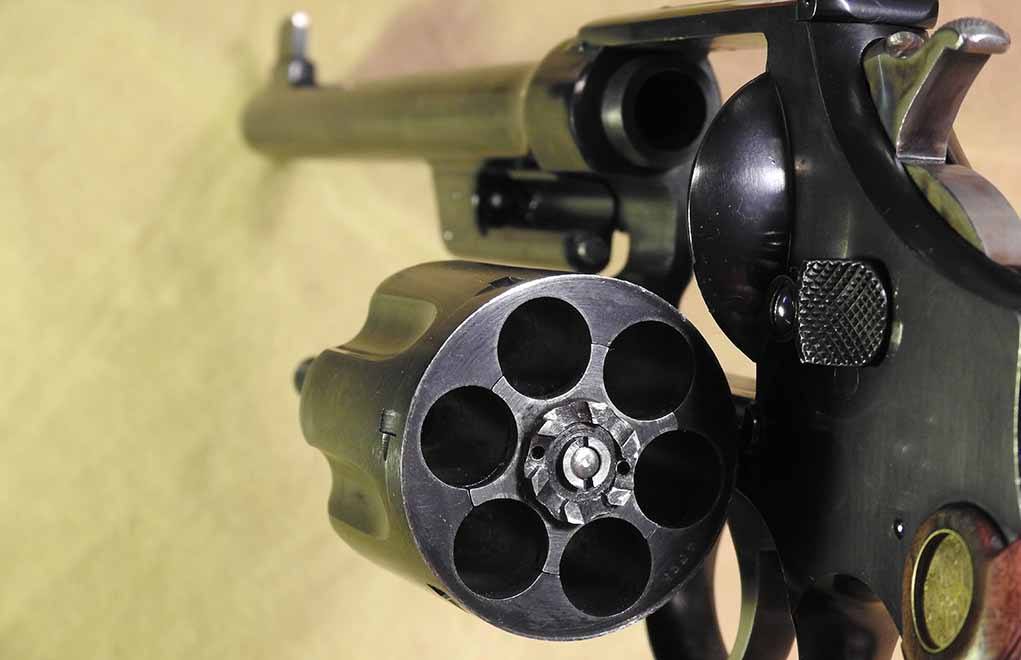
“I agree with what Elmer once wrote: ‘I’m a shooter, not a collector,’” Heskett said. “That’s why I shoot it—albeit with milder loads.”
He brought it out and let me shoot it too. We went through about 100 rounds of Heskett’s handloads with a formula he picked up from gun writer John Taffin: 6.0 grains of Unique powder with a 250-grain Keith bullet (an Elmer Keith semi-wadcutter design).
The action and trigger pull were smooth, accuracy consistent. It fit the hand well. Elmer was known to prefer smaller stocks. He was not a big guy. And that stock worked well for me. The front sight featured an inset Ed McGivern-designed Gold Dot, which provides a nicely noticeable visual reference point, even in subdued light.
Heskett explained that the smooth action and trigger pull are inherent, not a tune-up.
“That’s exactly the way I got it. It’s pretty characteristic. The early (Smith & Wesson) guns were noted for being very, very smooth … back when quality control was at the top of the list.”
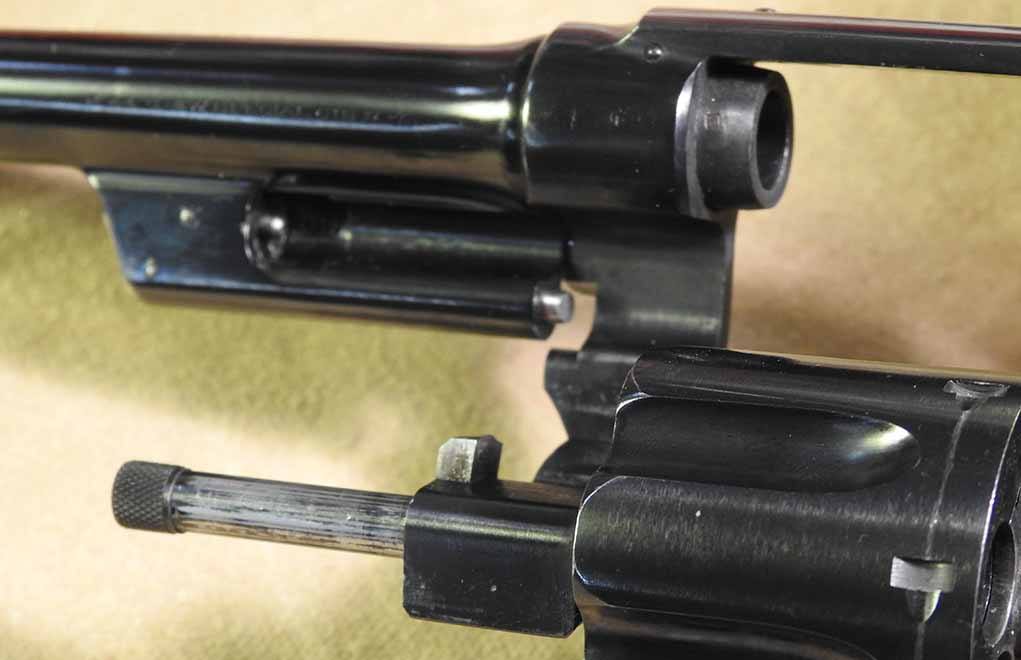
Heskett purchased the revolver in March 2016 from gunbroker.com. Previously, it had been sold at a 2015 auction offering Keith’s nearly intact firearms collection.
Other than the authentication from the auction house, including notes from Keith’s son, Ted, Heskett knows little of the role the revolver played in Keith’s work, how it came into his possession or its previous owners. He does know it was sent back to the factory in the 1920s for rebluing, but he doesn’t know if it was sent by Keith or a previous owner.
Heskett, a former police officer in Lincoln, Nebraska, and lifelong firearms collector, is now a rancher near Arnold (central Nebraska). He preferred not to reveal the price he paid for the revolver but said he was a long-time admirer of Keith and gets satisfaction of owning one of his personal handguns.
“I’ve been a big fan of Elmer’s ever since I was a kid. I suppose I shared a commonality with him—the love of six-guns; the fact that he had been a cowboy, rancher and a big-game hunter. And there was that connection with the West. I was basically all of those things, too, at one time or another,” he said.

Heskett said he admired Keith’s proficiency with wheelguns, in part, because he used to shoot in police competitions.
“I shot thousands and thousands of rounds through my competition revolvers, and I do love what you can do with a six-gun at long range,” he said.
Keith wrote about a 600-yard shot he made to stop a wounded deer from escaping over a hill. He drew criticism for taking the shot but made it clear he only did it because the deer had been hit by another hunter. He described walking the shots in and connecting, preventing the possible loss of the wounded animal.
With practice and know-how, long-range shots with a revolver are possible, Heskett said.
“It can be done, and Elmer was the one who could prove it. And he kind of led others to it.”
The article originally appeared in the August 2019 issue of Gun Digest the Magazine.

Next Step: Get your FREE Printable Target Pack
Enhance your shooting precision with our 62 MOA Targets, perfect for rifles and handguns. Crafted in collaboration with Storm Tactical for accuracy and versatility.
Subscribe to the Gun Digest email newsletter and get your downloadable target pack sent straight to your inbox. Stay updated with the latest firearms info in the industry.

![Best Concealed Carry Guns In 2025 [Field Tested] Wilson Combat EDC X9S 1](https://gundigest.com/wp-content/uploads/Wilson-Combat-EDC-X9S-1-324x160.jpg)


![Best 9mm Carbine: Affordable PCCs [Tested] Ruger Carbine Shooting](https://gundigest.com/wp-content/uploads/Ruger-Carbine-Shooting-100x70.jpg)
![Best AR-15: Top Options Available Today [Field Tested] Harrington and Richardson PSA XM177E2 feature](https://gundigest.com/wp-content/uploads/Harrington-and-Richardson-PSA-XM177E2-feature-100x70.jpg)
